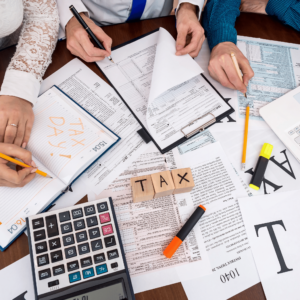Tax Reduction Strategies: A Guide for Singapore's Earners Planning Retirement
Collin Seow
Publish date: Fri, 13 Oct 2023, 07:00 PM
Introduction – Retirement in Singapore: Reduce Your Income Tax Burden
Are you concerned about the high income tax rates in Singapore as you prepare for retirement? You’re not alone in this predicament.
Singapore follows a progressive personal income tax system, with rates going up to 22%. To assist you in navigating through these intricate tax regulations, this blog post aims to provide you with valuable strategies and available reliefs to help alleviate your tax burden.
Are you ready to discover the hidden techniques of efficient tax planning? Let’s delve into tax brackets, IRA contributions, and tax breaks!
Key Takeaways
- Singapore has a progressive personal income tax rate of up to 22%, so understanding strategies to reduce your tax is crucial for earners planning retirement.
- Key tax relief schemes in Singapore include CPF top-ups and the Supplementary Retirement Scheme (SRS), which allow individuals to reduce their taxable income while building up retirement savings.
- Other significant tax relief schemes include Working Mother’s Child Relief, Qualifying Child Relief, Parenthood Tax Rebate, and Parent Relief for living with parents/grandparents, all of which provide significant financial support for retirement planning.
Individuals can also take advantage of Course Fee Relief for upgrading skills and deducting employment expenses, business expenses, rental expenses, and donations as part of their overall tax reduction strategies.

Grasping Singapore Income Tax System
When it comes to understanding income tax in Singapore, individuals need to familiarize themselves with the process of filing and paying personal income tax, know the different types of taxable income, calculate their chargeable income accurately, and be aware of the applicable income tax rates for 2023.
Process of filing and paying personal income tax
Navigating through the process of filing and paying personal income tax in Singapore is straightforward, provided you understand the steps involved.
- First, identify your source of income. This could include employment income, business income, or trade income.
- Begin by reporting your total earnings for the year on your tax return. Be sure to include all types of taxable income.
- Next, subtract any allowable expenses related to generating your income.
- Account for approved donations that are eligible for tax deductions.
- Calculate your chargeable income, which is your total income minus allowable expenses and approved donations.
- Use the latest IRAS progressive tax rates to calculate the amount of tax due based on the chargeable income.
- Ensure you meet all requirements for claiming reliefs and rebates such as SRS contributions or Parenthood Tax Rebates to reduce your taxable income further.
- Submit your completed personal income tax return to the Inland Revenue Authority of Singapore (IRAS) via e-filing or paper filing before the deadline.
- After successful submission, IRAS will send a Notice of Assessment (NOA) detailing how much tax you owe.
- Lastly, pay the amount stipulated in NOA by the due date using available payment modes.
Types of taxable income
In Singapore, traders and investors must grasp the different income types subject to taxation, as these categories significantly influence their tax obligations.
Employment income, encompassing all earnings and profits from one’s job, is generally taxable unless specific exemptions apply. Therefore, individuals must be aware of the various factors impacting their tax liability concerning their employment income.
Another crucial income type subject to taxation is rental income from properties. This category refers to earnings generated from property rentals. Non-resident individuals receiving rental income are currently mandated to pay tax at a rate of 22%. You need to comprehend the tax implications associated with rental income, particularly for non-residents.
Remember, when you pay taxes, your tax year can significantly impact these calculations.
Calculating Chargeable Income: Taxable Income Analysis
In Singapore, calculating chargeable income is a multi-step process that can be leveraged to lower your tax bill and determine your total tax. The process begins with the computation of your total income, including all earnings such as salary, bonuses, stock trading profit, and foreign interest income remitted into the country.
Subsequently, allowable deductions, which may include Central Provident Fund (CPF) contributions, are subtracted from this total amount to arrive at your assessable income. The process continues by subtracting further reductions from tax relief schemes offered by the Inland Revenue Authority of Singapore (IRAS).
The final figure, known as ‘chargeable income’, is taxed at progressive rates according to IRAS guidelines. Therefore, achieving an optimal chargeable income is crucial to effective retirement tax planning; it reduces your current liabilities and increases potential funds for future use.
Income tax rates for 2023
In 2023, Singapore’s income tax will operate on a progressive system. This framework levies higher tax rates on larger-income individuals, leading to a more substantial tax burden for those with higher earnings.
The income tax rates in 2023 range from 0% to 22.5% for all income earners, including traders and investors. This discussion will explore the impact and significance of the “higher tax bracket” within this progressive tax structure.
Here are these rates are broken down by income:
| Chargeable Income | Rate (%) | Gross Tax Payable ($) |
| Up to $20,000 | 0 | 0 |
| $20,001 to $30,000 | 2 | $200 |
| $30,001 to $40,000 | 3.5 | $550 |
| $40,001 to $80,000 | 7 | $2,800 |
| $80,001 to $120,000 | 11.5 | $4,600 |
| $120,001 to $160,000 | 15 | $7,200 |
| $160,001 to $200,000 | 18 | $10,200 |
| $200,001 to $320,000 | 19 | $13,950 |
| $320,001 and above | 22 | Subject to calculations |
Please remember that Singapore tax residents are subject to these progressive income tax rates.

Strategies for Tax Reduction in Retirement Planning
Discover Singapore’s various tax relief schemes that can aid in retirement planning, reduce your personal income tax and implement effective tax-saving strategies for income minimization.
These schemes are particularly beneficial for individuals seeking to optimize their retirement accounts and reduce their overall tax liability.
CPF Top-ups and Supplementary Retirement Scheme
The CPF Top-ups and Supplementary Retirement Scheme (SRS) are important ways to reduce taxable income, claim tax credits, and lower earned income for traders and investors in Singapore who are planning for retirement. These voluntary savings options offer a strategic way to build up your retirement savings while minimizing your tax liabilities.
One of the ways you can reduce your taxable income and claim tax credits is through the CPF Top-up, which allows individuals to contribute extra funds to their Central Provident Fund (CPF) account. Similarly, the SRS offers a different platform to save specifically for retirement, allowing you to lower your earned income and potentially save on income tax payments.
Both schemes offer tax deductions, providing opportunities to reduce taxable income and claim tax credits.
By taking advantage of these schemes, you can maximize your retirement savings while minimizing your tax liabilities, creating a win-win situation for savvy investors looking toward their future financial security.
Working Mother’s Child Relief, Qualifying Child Relief, and Parenthood Tax Rebate
Singapore offers a range of tax relief schemes to encourage earners’ retirement planning, including Working Mother’s Child Relief (WMCR), Qualifying Child Relief (QCR), and Parenthood Tax Rebate.
WMCR specifically aims at working mothers with Singapore Citizen children, offering tax relief up to $4,000 per child. QCR, on the other hand, allows both mothers and fathers to share this tax relief benefit for families with children.
The Parenthood Tax Rebate offers numerous strategies to help individuals maximize their savings.
This scheme incentivizes individuals across different income levels and those with varying modified adjusted gross incomes to plan for retirement effectively. By directly offsetting their tax liability, it can potentially lower their tax bracket, providing significant financial support for those planning their retirement. It’s crucial to leverage these strategies effectively to optimize future savings.
Parent/Grandparent Relief: Living Arrangement Benefit
Living with parents or grandparents in Singapore comes with significant tax advantages, and it’s a practical way to get tax relief and reduce your tax burden. The Parent Relief scheme is a key part of this strategy.
This scheme offers tax relief to those supporting their parents, grandparents, or parents-in-law. By claiming up to $9,000 per year in Parent Relief, individuals can provide care for their loved ones while significantly reducing their income tax liability.
This makes intergenerational living arrangements a compelling option for those planning for retirement and aiming to maximize savings.
Furthermore, the government’s focus on addressing the aging population in Singapore has promoted such tax relief measures, encouraging living arrangements that benefit both families’ and individuals’ financial health.
Course Fee Relief for upgrading skills
You can use Singapore’s Course Fee Relief scheme to maximize your tax savings while planning for retirement. This scheme encourages individuals to continuously upgrade their skills by offering tax relief courses that enhance their knowledge and expertise.
Participating in skill development programs or professional development courses, you gain valuable insights, stay relevant in your field, and reduce your income tax payments.
The Course Fee Relief scheme is part of the overall tax reduction strategies available to Singapore’s earners planning for retirement, allowing you to make the most of continuing education opportunities while enjoying significant tax benefits.
Employment expenses, business expenses, and rental expenses
In Singapore, tax residents planning for retirement can strategically reduce their income tax by leveraging various tax relief schemes. These include deductions on employment, business, and rental expenses from their taxable income.
Expenses incurred solely for generating income, whether from employment or business activities, are eligible for deductions. If you own rental properties, you can also claim deductions on qualifying rental expenses as part of your comprehensive tax planning strategy.
Effectively utilizing these deductions can significantly lower taxable income for traders and investors, leading to tax savings. Understanding the Inland Revenue Authority of Singapore (IRAS) guidelines on what constitutes deductible employment or business expenses is crucial.
This knowledge allows for the maximization of available deductions while ensuring regulatory compliance. Not all expenses are tax-deductible; only those meeting specific IRAS criteria qualify.
Remember that your contributions may be tax-deductible for those with a traditional IRA, and your investment income is not taxed until you withdraw. This can be a significant advantage for earners looking to reduce their tax burden.
However, it’s essential to understand the tax code and how your income will be taxed upon withdrawal. It’s also worth noting that sales from certain investments can also contribute to your taxable income. Therefore, it’s crucial to consider all sources of income and potential deductions when planning your tax strategy.
Donations for tax relief
A practical method to reduce income tax in Singapore involves making tax-deductible contributions to eligible charitable organizations. Individuals can lower their taxable income and enjoy tax savings by making cash or retirement asset donations to approved Institutions of Public Character (IPCs) or the Singapore government.
These philanthropic tax incentives positively impact the community and provide an opportunity for traders and investors to optimize their financial planning.
By contributing towards crucial social objectives, individuals can enjoy income tax savings while supporting causes that hold personal significance. It is important to note that the Inland Revenue Authority of Singapore (IRAS) has a list of approved donations that qualify for tax deductions, and exploring these options is crucial when planning contributions.
It is also worth considering factors such as the maximum tax relief available and the percentage of tax that can be saved through these donations.

Claiming Tax Relief and Rebates: Maximize Benefits, Claim Tax Credits, Get Tax Relief
Individuals can follow a straightforward process to claim tax relief and rebates in Singapore by submitting the necessary documents and information to the Inland Revenue Authority of Singapore (IRAS).
How to claim tax relief for various schemes
To claim tax relief for various schemes in Singapore, follow these steps:
- Identify the tax relief schemes you are eligible for based on your circumstances and financial situation.
- Ensure you meet all the eligibility criteria and requirements for each scheme.
- Gather all the necessary supporting documents and information to substantiate your claim for tax relief.
- Log in to the IRAS (Inland Revenue Authority of Singapore) myTaxPortal using your SingPass or IRAS Unique Account (IUA).
- Select the relevant form in the “File Income Tax Return” section.
- Enter the required details and information accurately.
- Look for the specific sections or fields where you can claim tax relief for each scheme.
- Provide all the necessary documentation or evidence to support your claims, such as receipts or certificates.
- Double-check all the information entered before submitting your tax return.
Submit your tax return electronically through the myTaxPortal by the stipulated deadline.

Illustration: Reducing Income Tax for YA 2024
Learn how to effectively reduce your income tax for YA 2024 with practical examples and step-by-step strategies. Maximize available tax relief schemes and start saving more for your retirement today.
Example of how to reduce income tax using available tax relief schemes
One effective way to reduce your income tax and capital gains tax liability in Singapore is by taking advantage of the various tax relief schemes available. For example, contributing to the Supplementary Retirement Scheme (SRS) can help lower your taxable income and is considered investment income.
Each dollar you contribute to your SRS account reduces your taxable income and is considered investment income by a dollar. This helps you save for retirement and provides immediate tax benefits, reducing your overall tax liability.
In addition to the SRS, exploring other tax relief options such as CPF top-ups, qualifying child relief, and employment expenses can further reduce your pay income tax and capital gains tax liability. Understanding the eligibility criteria for these reliefs and how they apply to your specific financial situation is crucial.
By maximizing these available tax relief schemes, you can effectively plan for their retirement while enjoying significant savings on their pay income tax and capital gains tax liability.
In summary, strategies like contributing to the SRS and exploring other eligible tax reliefs can significantly reduce pay income tax and capital gains tax liability in Singapore when planning for retirement.

Increase Retirement funds: Effective Ways to Reduce Your Taxable Income
Simplify your accounting process to streamline tax planning and ensure accurate reporting. Maximize available tax reliefs, rebates, and deductions to optimize your tax savings.
Simplifying accounting process
Simplifying the accounting process is crucial for effective tax planning, especially for traders and investors in Singapore.
By streamlining your financial records and organizing your expenses, you can maximize tax reliefs, rebates, and deductions available to you. This is particularly important when considering taxable income, as it allows you to implement various strategies to help reduce your tax burden.
To achieve this, tracking your business, rental, and employment expenses accurately is essential. Maintaining proper documentation simplifies the filing process when claiming tax relief schemes, such as course fee relief or donations for tax relief.
Additionally, staying organized throughout the year and adopting efficient accounting practices can help you optimize your tax efficiency and minimize your income tax obligations in Singapore, considering the relevant provisions of the Tax Cuts and jobs act.
Maximizing tax reliefs, rebates, and deductions
- Take advantage of tax deductions and reliefs to minimize your tax liability.
- Contribute to your CPF and SRS accounts for tax deductions on your taxable income.
- Consider topping up your CPF and SRS accounts to lower your chargeable income and reduce taxes.
- Itemize your deductions to maximize tax savings, especially if you are a high-income earner.
- Plan by strategically timing your expenses to optimize tax benefits.
- Explore various tax reduction strategies in Singapore, such as tax reliefs and rebates for retirement savings and financial planning.
- Singaporeans and Permanent Residents can benefit from CPF Cash Top-up Relief, encouraging them to save for retirement.
- Foreigners in Singapore can also explore ways to minimize their income tax liabilities.
- Make charitable donations or pursue educational courses to reduce your income tax obligations in Singapore legally.
- Insurance premiums may be eligible for tax deductibility in Singapore, providing additional opportunities for tax reduction.
Conclusion
In conclusion, developing and implementing an effective tax strategy is crucial for individuals in Singapore who are planning their retirement. By understanding and utilizing tax reduction strategies, individuals can significantly reduce their income tax burden, especially considering that income is taxed.
There are several avenues to explore to achieve this. Maximizing CPF contributions and taking advantage of the Supplementary Retirement Scheme (SRS) are just a few examples of options available. By leveraging these opportunities and being aware of the various tax reliefs, rebates, and deductions, individuals can optimize their savings while preparing for a financially secure retirement.
This can also potentially result in a lower tax bracket and further benefits, such as income from tax-exempt bonds.
By actively reducing your tax bill through careful planning and utilizing the appropriate tools and strategies, you can enhance your retirement savings and ensure a more comfortable financial future.
More articles on Collin Seow Remisier Blog
Created by Collin Seow | Aug 14, 2024
Created by Collin Seow | Jul 31, 2024
Created by Collin Seow | Jun 26, 2024
Created by Collin Seow | May 29, 2024
Created by Collin Seow | May 15, 2024
Created by Collin Seow | Apr 24, 2024
Created by Collin Seow | Apr 19, 2024




















